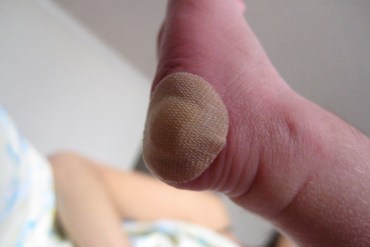Stanford University scientists say they’ve devised a more accurate and comprehensive DNA test to screen newborns for cystic fibrosis, the most common fatal genetic disease in the United States.
Affecting about one in 3,900 babies born in the U.S., cystic fibrosis causes mucus to build up in the lungs, pancreas and other organs, leading to frequent lung infections and often requiring lifetime treatment for patients, whose median lifespan is 37 years.
Every state screens newborns for cystic fibrosis, but the current sequence of tests can miss cases, threatening babies’ lives.

The new DNA test to screen newborns for cystic fibrosis uses blood taken during the common newborn heel stick. (Maile and Justin McCarthy/Flickr)
The new method, presented in a study published Monday in The Journal of Molecular Diagnostics, promises to be more efficient and cost-effective, researchers said. It may also improve screening for non-white babies, for whom cystic fibrosis is rarer and harder to diagnose.
“I think this is a major advance. It offers the promise of potentially eliminating the false negative results that lead to missed cases,” said Dr. Philip Farrell, a former dean of the University of Wisconsin School of Medicine and Public Health, and a nationally-known expert on cystic fibrosis screening for newborns. “If you miss a case, you’ve got a baby out there who has a significant possibility of dying undiagnosed.”
Cystic fibrosis is caused by a defect in the CFTR gene, which regulates the movement of water and salt out of the body’s cells. In California, current genetic screens look for 40 of the most common mutations of the CFTR gene in newborns. Yet any of the more than 2,000 known mutations in that gene could play a role in the disease, and there are likely others that have not yet been discovered.
The new test uses “next generation” DNA sequencing that can quickly and more cheaply look at the entire CFTR gene, not just selected mutations. It does not require an extra blood sample. Rather, it uses the tiny amount of blood drawn from the common newborn heel stick test that’s already used to screen for a number of diseases, including cystic fibrosis.
The researchers say this advance can enable testing labs to review many newborn samples at a time and reduce costs, allowing a technology previously used only to diagnose individual cases to be applied to a large population.
“Next generation” DNA sequencing has been used in recent years to diagnose disease, but is only now becoming cheap and fast enough to even be considered for large-scale population screening. About 500,000 newborns are screened in California each year.
Scientists from Stanford, the California Department of Public Health, and the University of Texas conducted the research. Other U.S. scientists have been working on similar newborn screening approaches using next-generation DNA sequencing.
The test is not only quicker and cheaper, but also “very accurate,” said Dr. Iris Schrijver, a Stanford University Medical School pathology professor who is one of the study’s authors. “We can look at the entire gene and assess … all kinds of mutations in this single test,” possibly in half the time of a current DNA test, Schrijver said.
California started screening newborns for cystic fibrosis in 2007. The screening involves several analyses, the first of which is a simple enzyme test that looks for elevated levels of a pancreatic substance associated with cystic fibrosis.
If the finding is positive, the next step is the current DNA screening test. Babies testing positive on that receive additional diagnostic tests to confirm the disease.
Not all infants with genetic mutations for cystic fibrosis will develop the disease. For that to happen, they need to inherit two copies of the defective gene, one from each parent. Babies with only one copy of the bad gene will not develop the disease, but they are carriers who could pass it to their own children.
About 30,000 children and adults in the US have cystic fibrosis, and about 10 million are carriers.
A spokesman for the California Department of Public Health, which oversees newborn screenings, said the current cost, including DNA testing, is approximately $113 per newborn, which is typically covered by insurers.
The department declined to make one of its scientists, a co-author of the study, available for an interview. It also declined to respond directly to questions about the cost of these new tests or whether it might adopt them.
In general, the spokesman noted, the agency’s newborn screening program evaluates potential new testing methods for effectiveness and cost.
“Historically, changes to existing testing methods have been rare, so the department cannot speculate on a timeline for this process,” the spokesman wrote in an email.
However, a Stanford spokeswoman said its laboratory is currently running side-by-side comparisons of the new test and the current one, and its lab physicians expect to meet with public state health officials within the year to discuss next steps.


